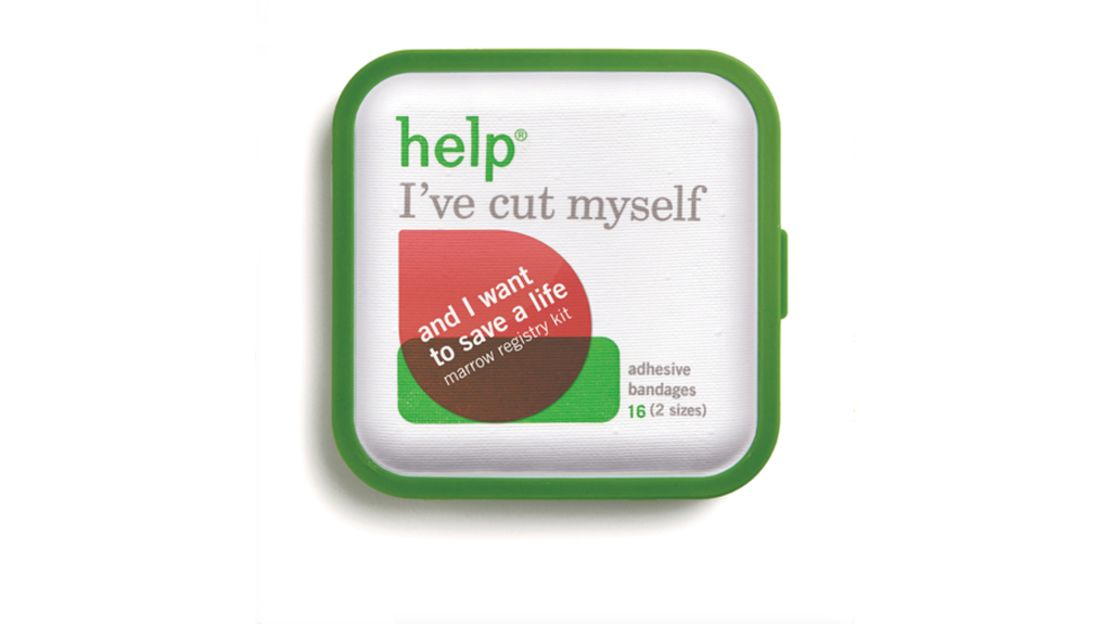Story highlights
Help Remedies has teamed up with the largest bone marrow donor center
More than 10,000 people need a bone marrow transplant from an unrelated donor
Only one in 540 donors will be matched with a patient in need
Registering to become a bone marrow donor just became as simple as tending to a paper cut.
Help Remedies, a small health care products company, has recently teamed up with DKMS, the world’s largest bone marrow donor center, to release Help: I Want to Save a Life. The product contains 16 adhesive bandages and a bone marrow testing kit.
Now when people cut themselves and search for a bandage they can dab their blood with a cotton swab, place it in the pre-packaged envelope, and mail it into the lab. After mailing in the kit, people fill out a brief form online and are instantly added to the United States national bone marrow registry, called Be the Match.
“The magic of this idea is that it just feels like it’s part of the process,” said Nathan Frank, co-founder and creative director of Help Remedies. “You cut yourself, you dip it [the test] in blood. You don’t step out of what you’re doing physically or mentally.”
According to the National Marrow Donor Program, more than 10,000 people in the United States are diagnosed with diseases every year, the only cure being a bone marrow transplant from an unrelated donor. Patients need donors who are a close genetic match, and ethnicity/heritage are key in making that match.
The Be the Match Registry has more than 9.5 million donors (300,000 of whom are associated with DKMS), but only one in 540 will be matched with a patient in need. Help Remedies and DKMS are hoping to improve those statistics.
Part of this product’s appeal is that customers can purchase Help: I Want to Save a Life and satisfy their altruistic side without paying extra. Customers pay $4, the cost of the bandages.

“It is basically an add-on and people can have the benefit of the kit without paying extra,” Frank said. “They shouldn’t have to pay extra to do something good. We wanted to give this as a gift to people.”
While Help: I Want to Save a Life is produced by Help Remedies, the idea comes from an outside source. Graham Douglas thought of the idea after watching his brother Britton battle leukemia and struggle to find a bone marrow donor.
“During the whole process of finding a donor we realized it’s really a glorified lottery, and the odds aren’t in your favor,” said Douglas. “That never really sat well with me.”
For the last 10 years, Douglas has been working to simplify the registration process. Before Help: I Want to Save a Life, potential donors had to go out of their way to make a doctor’s appointment, attend a donor center event or make the conscious decision to search for a kit online.
“Another reason I did this was to show how stupidly simple it can be,” Douglas said. “To get your name on a list it just takes a couple drops of blood. You don’t even have to bloody yourself; we wanted to catch people while they were already bleeding.”
Once listed as a donor, a person’s tissue type and identification number are anonymously stored in the registry. Doctors can then search through the registry for donors who match their patients’ tissue types. Donors may be asked to participate in a transplant but have the right to decline or change their minds.
Once a donor backs outs, his or her name is removed from the registry so as not to give false hope to other ailing patients. A donor’s name is also removed after his/her 61st birthday, because the risks associated with anesthesia increase with age.
“When a donor backs out, it is devastating news for the family,” said Alina Suprunova, director of special projects of DKMS Americas. “We ask that when registering that our donors consider the commitment they are making to the patients.”
During a bone marrow transplant a donor’s blood-forming stem cells are directly transfused into a patient’s bloodstream. The patient’s new stem cells later multiply to create healthy bone marrow.
There are two methods of donation.
Peripheral blood stem cell donation is a nonsurgical procedure in which stem cells are collected from a donors’ bloodstream. Four days before the donation, as well as the day of stem cell collection, a donor receives daily injections of a synthetic protein to increase the number of stem cells in the blood.
On the day of collection, blood is taken from one arm and passed through an apheresis machine to separate stem cells from the blood. The remaining blood is then returned to the donor intravenously through the other arm. The whole process takes about four to six hours over the course of a day, and it takes a few weeks for the donor to completely regenerate the lost cells.
In a bone marrow donation, actual marrow cells are taken from the back of the donor’s pelvic bone with a syringe. The donor receives general anesthesia to eliminate pain during the one- to two-hour surgical procedure and their marrow is restored within a few weeks.
“I want to get rid of this storm of misconception around registering and donating,” Graham said. “I want to make sure people know marrow is just a numbers game, and we’re losing but we don’t have to be.”
Initially released online on February 27, Help: I Want to Save a Life has since been picked up by Target and Walgreens, which promises to expand the product’s audience by thousands. People interested in becoming marrow donors can also go to the DKMS website, register online and request a free bone marrow test kit.

